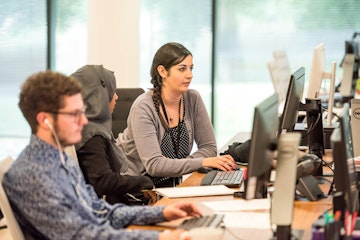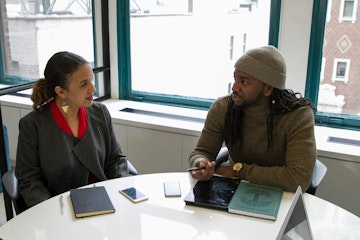Course Spotlight
Everything You Need to Know About General Assembly’s Revamped User Experience Design Immersive

![]()
Written By Jess Feldman
![]()
Edited By Liz Eggleston

![]()
Written By Jess Feldman
![]()
Edited By Liz Eggleston
Course Report strives to create the most trust-worthy content about coding bootcamps. Read more about Course Report’s Editorial Policy and How We Make Money.
Course Report strives to create the most trust-worthy content about coding bootcamps. Read more about Course Report’s Editorial Policy and How We Make Money.
The UX Design job market is changing, and General Assembly just revamped their User Experience Design Immersive to evolve with it (plus you can now take the UXDI online). We talked to Instructional Designer Emily Roberts to find out what’s new in the curriculum, the ideal UXDI student, and the types of jobs that new graduates will be able to land in UX Design.
What do you work on at General Assembly?
I am an Instructional Designer at General Assembly. I interview experts in the field like User Experience Designers, User Researchers, and Visual Designers, and then translate their knowledge and insights into fun, relevant, and effective learning experiences.
There are so many bootcamps these days – what inspired you to work for General Assembly specifically?
I've been with General Assembly since 2015. As cheesy as it sounds, I love General Assembly for its mission. Every day I'm surprised by how positive, productive, and effective an entire company can be when we're all aligned to a noble purpose. I'd describe our mission as making high-quality education for in-demand skills and making that accessible to as many people as possible. Regardless of your physical location, physical ability, or credit score, General Assembly gives you access to education.
Tell us about the UX/UI curriculum revamp! What's new?
The biggest difference is that we're expanding the course from a 10-week program to a 12-week program. Our Software Engineering Immersive and Data Science Immersive are both 12-weeks long. In the feedback we collected, students and instructors both wanted the program to be longer. Also, we added in a remote modality!
In terms of the curriculum, these are the three main additions:
Visual Design: We added visual design skills and techniques so that our curriculum is more holistic. We've always had great research and testing materials, but adding this component of design better equips our students to answer questions like, "How does the composition of my design affect the usability of this experience?" and "How can I improve this design?" While that isn't a requirement for all UX roles like UX Researcher, it is definitely a part of the entire UX process.
Product Management: Product management is an in-demand skillset! The new curriculum delves into pitching a product, making a product or project plan, prioritization, and agreeing on a Minimum Viable Product. It’s important for our graduates to know how designers work with developers as well as the larger product team.
Career Planning: We've always had career coaches in UXDI, but now we’ve added introductory lessons based on the career framework. We go over the skills that are required for leadership positions in the industry. We also show students how, as an entry-level designer, graduates can work with someone in a more senior role right out of bootcamp while also grooming themselves to take on senior roles in the future.
What prompted General Assembly to update the User Experience Design curriculum?
First and foremost, it was time. The UX industry changes and our goal is to make sure we're developing a curriculum that prepares graduates for entry-level positions. We are also huge fans of feedback here at General Assembly. This curriculum applies all of the insights from the feedback we collected. Lastly, General Assembly works with standards boards, a collection of industry experts that serve to help us design a career framework. They help us answer questions like, "What skills are required for an entry-level position?" or "What skills are required for a leadership position?" From their experiences in the industry and working in the field, they help us identify those skills to be included in the career framework. We're addressing each of those skills identified by that standards board in our new curriculum.
How have you seen the UX/UI Design market change over the past couple of years and where do you see it moving next?
We're now thinking beyond phones and desktops, and more about artificial intelligence, virtual reality, augmented reality, voice interfaces, and wearables. Those are all new interfaces and experiences that need to be designed! From conversations that I've had with people in the field, I've gathered that an increase in non-design skills like product management, leadership skills, and influencing are the biggest things that have changed in the industry. Keeping up with those tech trends and skills making user experience principles for new experiences will be the direction of UXDI curriculum in the future.
How is this new UX curriculum going to make students more marketable as designers when they graduate?
Students can expect to secure positions like UX Designer, UI Designer, Usability Tester, Usability Specialist. Junior or entry-level positions are to be expected, just like our old curriculum. This revamp makes sure that students are eligible and qualified for entry-level positions when they graduate.
There are several ways that we wanted to address graduate marketability because our primary focus is getting folks jobs.
Projects: Students will now be expected to do 6 projects across the 12 weeks (before, they did 5 projects across 10 weeks). The sixth project is a Passion Project. It asks the student, "How do you as an entry-level designer who is applying for jobs make yourself stand out in a way that's interesting to recruiters and other designers?" The project allows students to show what makes them unique as a designer that they can apply to their design thinking and skills.
Diverse Portfolios: We're making sure that we're keeping students up-to-date on newer topics. Our UXDI students will have mobile apps, responsive web apps, a real-life client project, and their passion project in their portfolio. The real-life client will be a start-up and that project is done in a group. Students will be leaving with a holistic approach to what they can offer.
Non-Design Skills: To reiterate, those non-design skills are increasingly important! We're teaching them how to work with developers, design leadership, products, and product managers. Those are solid foundations for someone's success at a company. There's going to be a learning curve in their first role and every company is different, but we want to make sure students are ready to be a good member of any team.
Why is General Assembly offering a remote option for the UX Design Immersive?
General Assembly decided to add the remote modality to make these in-demand skills as accessible to people as possible. To us, accessibility includes both physical location and physical ability. We have 17 full campuses worldwide and nine pop-up campuses in the U.S., but that's not everywhere. We wanted to offer our curriculum to folks who either don't live near one of our campuses or it's not feasible to be on one of our campuses full-time for 12-weeks. In terms of what is covered, there is no difference between the in-person and online programs. The delivery of the curriculum is the only difference.
In the remote program, how do students and instructors communicate with each other?
The remote UX Design Immersive is a live, synchronous learning experience. From 9AM to 5PM, students will be in a virtual classroom with instructors and other students. They can expect to interact with their instructors and fellow students 40 hours a week. The classes are attended via video conferencing and instant messaging, the same way people work remotely for companies like GitHub or Intuit.
Are students working together on projects in the remote version of the program?
Two of the six projects are group projects, which is the same for the in-person option. Students will be interacting with each other through Zoom video conferencing. Our online team has done an incredible job teaching our instructors how to facilitate a classroom experience remotely. We’ve run our Software Engineering Immersive in a remote modality and so we already had a keen understanding of how to structure this so it works well. Teams of students will be able to gather in breakout rooms via Zoom. Instructors can float between the breakout groups, just like they would float around between groups in person from table to table. Students can also use Slack groups to communicate for projects.
What does the online learning platform look like?
The learning platform is a proprietary learning management system called myGA. Students have access to 12 hours of curriculum that they're expected to do before the first class and that's available to them throughout the entire course. Other than that, students are not learning on their own on our platform. Students are primarily interacting with each other on Zoom, Slack, and Miro Boards.
Who is the ideal student for General Assembly's new curriculum?
Whether we're talking about the in-person or the remote version, we're looking for folks who are willing to work hard. Someone who is motivated and inspired to change their career. We're not expecting students to not falter at all. We know it's a big step! But motivation is key. You wouldn't train for a marathon if you weren't motivated. Will you love every run? Probably not. But you have that goal, you want to do it, and you're going to do it. The remote version of this course will work best for students who are willing to set up their own learning space and dedicate eight hours a day to this program without being in a separate physical space.
If someone is a complete beginner, how do they get up to speed before starting in on the User Experience Design Immersive?
A new beginner can absolutely jump into our program! We have a 12-hour online asynchronous program that students are required to complete before the first class. It introduces students to UX Design and gets them familiar with the concepts that they will later dive into deeper during the course.
How can a prospective student decide if UX is the right field for them?
Focus on some of our shorter form classes and workshops. We have 2-hour classes and 2-day workshops that will give folks a better idea of what UX is, what the industry is like, and what jobs in the field may entail.
Has the admissions process changed at all?
The admissions process is still the same! There will be a phone call, interviews, sample tasks, and financial conversations.
What is the biggest lesson that you've learned at General Assembly and how are you bringing those lessons to this new curriculum?
I've learned to ask evaluating questions while I'm creating a curriculum. I ask myself, "Does the student need to know this? Is it applicable to the real world?" If the answer to those questions is no, we deprioritize that element. These questions help streamline when we're designing the material and the in-classroom experience. We want to break the vacuum seal of a traditional classroom.
It can be defeating for a student who is wondering if they really need to know the material they’re paying to learn. Our philosophy here at General Assembly is to design our courses to be able to answer those questions immediately. Students should not have to question how they're going to use something that we're teaching them in the real world. But we also want students to feel comfortable enough to ask why they’re learning something.
Do you have any tips for students to get the most out of bootcamp when they're trying to change careers?
Have a network of people or at least one person who can be there for you throughout this experience. That can mean financially, emotionally, a place to stay, a good listener. Being emotionally aware is important. Emotions can get in the way of learning sometimes. Know who your support system is, who you can go to when you're having a hard time. Once you get started in a bootcamp, be ready to create that network with your cohort, too! Try to remain positive. Honestly, this is all basically advice for life in general. What makes you a happy productive person in your real life will also make you a happy productive student in this course.
When does the new curriculum launch?
It’s being launched in March! March 9th is when all on-campus cohorts will start using UXDI 4.0 curriculum, and our first remote cohort launches March 30th. Students can begin enrolling on February 11th!
Find out more and read General Assembly reviews on Course Report. This article was produced by the Course Report team in partnership with General Assembly.

Jess Feldman, Content Manager at Course Report
Jess Feldman is an accomplished writer and the Content Manager at Course Report, the leading platform for career changers who are exploring coding bootcamps. With a background in writing, teaching, and social media management, Jess plays a pivotal role in helping Course Report readers make informed decisions about their educational journey.

Liz Eggleston, CEO and Editor of Course Report
Liz Eggleston is co-founder of Course Report, the most complete resource for students choosing a coding bootcamp. Liz has dedicated her career to empowering passionate career changers to break into tech, providing valuable insights and guidance in the rapidly evolving field of tech education. At Course Report, Liz has built a trusted platform that helps thousands of students navigate the complex landscape of coding bootcamps.










Sign up for our newsletter and receive our free guide to paying for a bootcamp.
Just tell us who you are and what you’re searching for, we’ll handle the rest.
Match Me